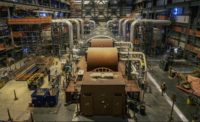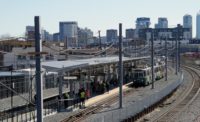The master plan called for dividing the megablock into eight smaller blocks by punching through closed city streets and creating public pedestrian alleys between the buildings. There was resistance to the idea because the consequent smaller building footprints can be more difficult to lease, says Yakubu.
"Everyone was thinking about large malls," he adds. "There was a strong urge [on the part of the stakeholders] to create something suburban."
Foster resisted the pressure. All the street-level frontage, except for three garage entrances and modest-size building entrances, is reserved for shops—in phase one alone, a total of 4,200 lineal ft. All deliveries and service vehicles will enter the garage and drive, Disney-style, to a loading dock on the top basement level under each building. Then, they will rotate on a turntable and drive out of the basement.
Foster did not begin the master plan until July 2005, 20 months after the city selected the Hines team in November 2003. The city had delayed its promised announcement of a winner a couple of times, stretching out the competition phase to 14 months.
The exclusive-rights agreement was completed in summer 2004, but the City Council did not give its nod until the next summer. In December 2006, the city and the developer executed their agreement. Schematic design and zoning approvals began in October 2006 and took 14 months, followed by 42 months for design development, working drawings—completed in April 2009—and permitting and approvals.
General-contractor bidding and selection took a year. In February 2009, Hines awarded the contract to the local Clark/Smoot, A Joint Venture, which comprises Clark Construction Group, Bethesda, Md., and the local Smoot Construction D.C. Almost immediately after the selection of the GC, the project stalled.
During the long gestation period, the biggest headache for the developer, the designers and the GC was maintaining team continuity. During the hiatus, the biggest problem was maintaining a state of readiness.
 |
| HAAS |
CityCenterDC is a development of Hines and The TFI US Real Estate Fund. The anchor investor in the fund is Qatari Diar Real Estate Investment Co., an arm of the Qatar Investment Authority.
Regardless of the economic downturn, City-CenterDC is a "very complicated project and requires a significant amount of capital," says Riker. "There are a limited number of entities willing to participate."
"The project was supposed to start several times along the way—at a moment's notice," says Matt Haas, a vice president of Clark Construction Group, Bethesda, Md., and project director for Clark/Smoot.










Post a comment to this article
Report Abusive Comment